In the Swedish silent film Klostret i Sendomir/The Monastery of Sendomir (1920), two weary travellers come upon a monastery. While staying the night, they learn of its mysterious founding. Director Victor Sjöström adapted an 1828 short story by Franz Grillparzer for this historical melodrama. Stars were Tora Teje, Renée Björling, Richard Lund and Tore Svennberg.

Swedish postcard by Förlag Nordisk Konst, Stockholm, no. 1092/2. Photo: Svenska Biografteatern. Publicity still for Klostret i Sendomir/The Monastery of Sendomir (Victor Sjöström, 1920) with Tora Teje.

Swedish postcard by Förlag Nordisk Konst, Stockholm, no. 1092/3. Photo: Svenska Biografteatern. Publicity still for Klostret i Sendomir/The Monastery of Sendomir (Victor Sjöström, 1920) with Renée Björling and Tora Teje.
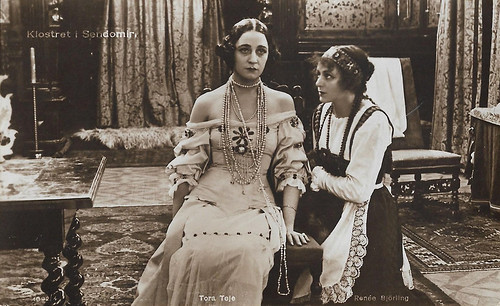
Swedish postcard by Förlag Nordisk Konst, Stockholm, no. 1092/4. Photo: Svenska Biografteatern. Publicity still for Klostret i Sendomir/The Monastery of Sendomir (Victor Sjöström, 1920) with Tora Teje and Renée Björling.
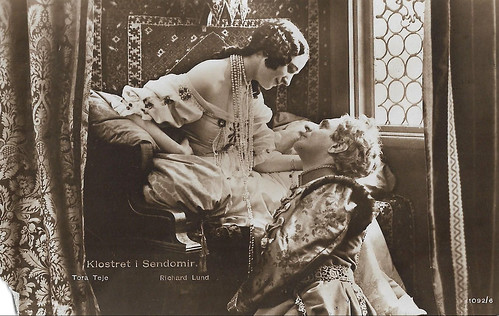
Swedish postcard by Förlag Nordisk Konst, Stockholm, no. 1092/6. Photo: Svenska Biografteatern. Publicity still for Klostret i Sendomir/The Monastery of Sendomir (Victor Sjöström, 1920) with Tora Teje and Richard Lund.

Swedish postcard by Förlag Nordisk Konst, Stockholm, no. 1092/7. Photo: Svenska Biografteatern. Tora Teje, Richard Lund, and Renée Björling in Klostret i Sendomir/The Monastery of Sendomir (Victor Sjöström, 1920)
The main part of Klostret i Sendomir/The Monastery of Sendomir (Victor Sjöström, 1920) is told in a flashback by a monk to two visiting noblemen on their way to Warsaw in the 17th century. The two noblemen arrive at the monastery of Sendomir (Sandomierz) and ask for passing the night. They are served by a very humble and somewhat strange old monk. When they ask about the monastery's history, the monk becomes very upset, yet he begins to tell about the events that led to the monastery's arrival. Near the place where the monastery now stands, once stood a large and magnificent castle, where the mighty Count Starschensky (Tore Svennberg) lived happily with his rather saddened, younger wife Elga (Tora Teje), her child and their servants.
One day, the Count's staff receives reports that unknown persons sometimes get access to the castle via a certain gate. The administrator informs the Count of his findings, and the Count detects that the key to the corresponding porch is missing. When the Count returns next time, he notices that an officer (Richard Lund) is secretly let in through the gate by the Countess's maid-in-law (Renée Björling).
The chambermaid detects after a while that the Count is on his way back, summoned by his servants. The lover succeeds in escaping and the Count cannot induce the chambermaid to give his name. Elga spells her fierce anger, but remains very cold and succeeds in letting him believe that it is just her maid getting these secret visits. The Count takes relief from this false interpretation of the course of events. Shortly thereafter, he realises he has been fooled. Tucked away in a box, he recognises a picture of a cousin to his wife, Oginsky, who has become his wife's lover. The Count is shocked by the suspicion that Oginsky may be the father of the daughter (Gun Robertson) he considered as his own.
With the administrator's help, the Count sets a trap and captures Oginsky. He forces her wife to get up at night and leads her to the captive Oginsky who confesses having made love to the Countess and being the father of her child. The lover can escape through a window. The countess prays for her life and, on her husband's request (testing her), she is even prepared to kill her 'untimely' child by her own hands, just to save her skin. This takes the count as the definitive proof of her unworthiness to live. He drives his knife into her. That same night, the castle burns to the ground, and a poor local wife gets the little girl with a promise of money for her education.
The monk concludes his story by telling that the count left the estate and his belongings to the monastery which he was able to institute after his crime. The guests ask the monk what happened to the count himself and get the answer that he became an insignificant and impoverished brother in his own monastery. They discover that the monk is Starschensky himself. Though critics admitted that Klostret i Sendomir was a melodramatic story, they emphasised that the melodrama was embedded within artistic consistency and authenticity. The wonderful cinematography was lauded as well as the impressive studio resources that could create this 17th century ambiance. Tore Svennberg and Tora Teje's performances were also admired
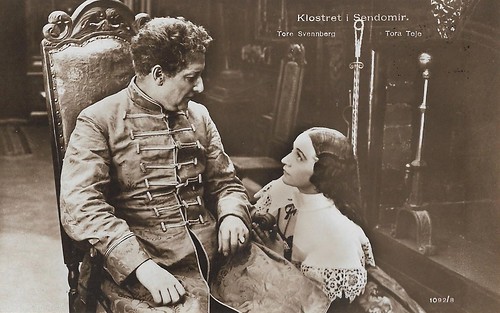
Swedish postcard by Förlag Nordisk Konst, Stockholm, no. 1092/8. Photo: publicity still for Klostret i Sendomir/The Monastery of Sendomir (Victor Sjöström, 1920) with Tore Svennberg and Tora Teje.
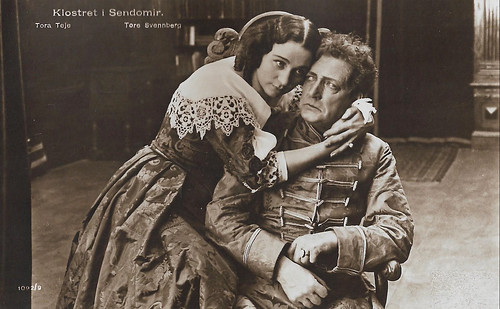
Swedish postcard by Förlag Nordisk Konst, Stockholm, no. 1092/9. Photo: Svenska Biografteatern. Publicity still for Klostret i Sendomir/The Monastery of Sendomir (Victor Sjöström, 1920) with Tora Teje and Tore Svennberg.
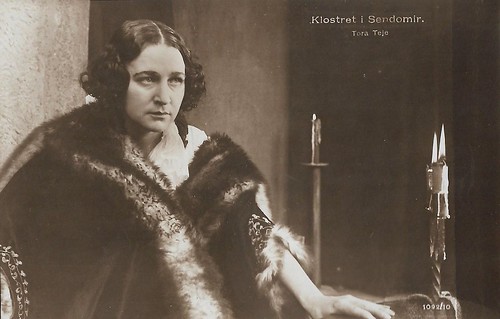
Swedish postcard by Förlag Nordisk Konst, Stockholm, no. 1092/10. Photo: Svenska Biografteatern. Publicity still for Klostret i Sendomir/The Monastery of Sendomir (Victor Sjöström, 1920) with Tora Teje.

Swedish postcard by Förlag Nordisk Konst, Stockholm, no. 1092/11. Photo: Svenska Biografteatern. Publicity still for Klostret i Sendomir/The Monastery of Sendomir (Victor Sjöström, 1920) with Tore Svennberg, Richard Lund and Tora Teje.
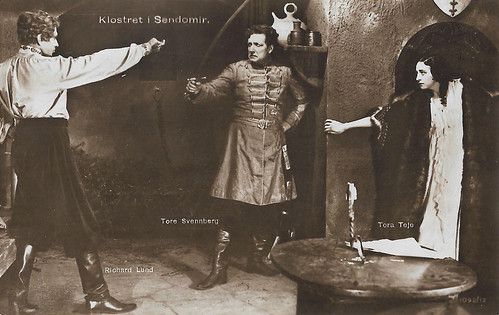
Swedish postcard by Förlag Nordisk Konst, Stockholm, no. 1092/12. Photo: Svenska Biografteatern. Publicity still for Klostret i Sendomir/The Monastery of Sendomir (Victor Sjöström, 1920) with Richard Lund, Tore Svennberg and Tora Teje.

Swedish postcard by Förlag Nordisk Konst, Stockholm, no. 1092/13. Photo: Svenska Biografteatern. Publicity still for Klostret i Sendomir/The Monastery of Sendomir (Victor Sjöström, 1920) with Tora Teje and Tore Svennberg.
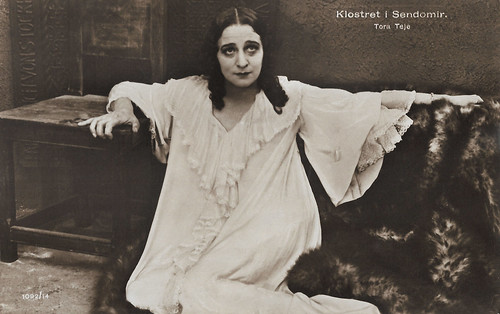
Swedish postcard by Förlag Nordisk Konst, Stockholm, no. 1092/14. Photo: Svenska Biografteatern. Publicity still for Klostret i Sendomir/The Monastery of Sendomir (Victor Sjöström, 1920) with Tora Teje.
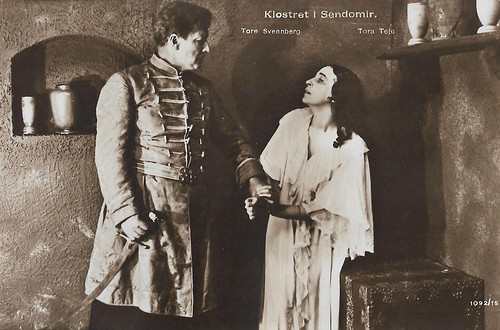
Swedish postcard by Förlag Nordisk Konst, Stockholm, no. 1092/15. Photo: Svenska Biografteatern. Publicity still for Klostret i Sendomir/The Monastery of Sendomir (Victor Sjöström, 1920) with Tore Svennberg and Tora Teje.
Sources: Svenskfilmdatabas.se, Wikipedia (English and Swedish), and IMDb.
This post was last updated on 31 July 2024.

Swedish postcard by Förlag Nordisk Konst, Stockholm, no. 1092/2. Photo: Svenska Biografteatern. Publicity still for Klostret i Sendomir/The Monastery of Sendomir (Victor Sjöström, 1920) with Tora Teje.

Swedish postcard by Förlag Nordisk Konst, Stockholm, no. 1092/3. Photo: Svenska Biografteatern. Publicity still for Klostret i Sendomir/The Monastery of Sendomir (Victor Sjöström, 1920) with Renée Björling and Tora Teje.

Swedish postcard by Förlag Nordisk Konst, Stockholm, no. 1092/4. Photo: Svenska Biografteatern. Publicity still for Klostret i Sendomir/The Monastery of Sendomir (Victor Sjöström, 1920) with Tora Teje and Renée Björling.

Swedish postcard by Förlag Nordisk Konst, Stockholm, no. 1092/6. Photo: Svenska Biografteatern. Publicity still for Klostret i Sendomir/The Monastery of Sendomir (Victor Sjöström, 1920) with Tora Teje and Richard Lund.

Swedish postcard by Förlag Nordisk Konst, Stockholm, no. 1092/7. Photo: Svenska Biografteatern. Tora Teje, Richard Lund, and Renée Björling in Klostret i Sendomir/The Monastery of Sendomir (Victor Sjöström, 1920)
The sad story of a strange, old monk
The main part of Klostret i Sendomir/The Monastery of Sendomir (Victor Sjöström, 1920) is told in a flashback by a monk to two visiting noblemen on their way to Warsaw in the 17th century. The two noblemen arrive at the monastery of Sendomir (Sandomierz) and ask for passing the night. They are served by a very humble and somewhat strange old monk. When they ask about the monastery's history, the monk becomes very upset, yet he begins to tell about the events that led to the monastery's arrival. Near the place where the monastery now stands, once stood a large and magnificent castle, where the mighty Count Starschensky (Tore Svennberg) lived happily with his rather saddened, younger wife Elga (Tora Teje), her child and their servants.
One day, the Count's staff receives reports that unknown persons sometimes get access to the castle via a certain gate. The administrator informs the Count of his findings, and the Count detects that the key to the corresponding porch is missing. When the Count returns next time, he notices that an officer (Richard Lund) is secretly let in through the gate by the Countess's maid-in-law (Renée Björling).
The chambermaid detects after a while that the Count is on his way back, summoned by his servants. The lover succeeds in escaping and the Count cannot induce the chambermaid to give his name. Elga spells her fierce anger, but remains very cold and succeeds in letting him believe that it is just her maid getting these secret visits. The Count takes relief from this false interpretation of the course of events. Shortly thereafter, he realises he has been fooled. Tucked away in a box, he recognises a picture of a cousin to his wife, Oginsky, who has become his wife's lover. The Count is shocked by the suspicion that Oginsky may be the father of the daughter (Gun Robertson) he considered as his own.
With the administrator's help, the Count sets a trap and captures Oginsky. He forces her wife to get up at night and leads her to the captive Oginsky who confesses having made love to the Countess and being the father of her child. The lover can escape through a window. The countess prays for her life and, on her husband's request (testing her), she is even prepared to kill her 'untimely' child by her own hands, just to save her skin. This takes the count as the definitive proof of her unworthiness to live. He drives his knife into her. That same night, the castle burns to the ground, and a poor local wife gets the little girl with a promise of money for her education.
The monk concludes his story by telling that the count left the estate and his belongings to the monastery which he was able to institute after his crime. The guests ask the monk what happened to the count himself and get the answer that he became an insignificant and impoverished brother in his own monastery. They discover that the monk is Starschensky himself. Though critics admitted that Klostret i Sendomir was a melodramatic story, they emphasised that the melodrama was embedded within artistic consistency and authenticity. The wonderful cinematography was lauded as well as the impressive studio resources that could create this 17th century ambiance. Tore Svennberg and Tora Teje's performances were also admired

Swedish postcard by Förlag Nordisk Konst, Stockholm, no. 1092/8. Photo: publicity still for Klostret i Sendomir/The Monastery of Sendomir (Victor Sjöström, 1920) with Tore Svennberg and Tora Teje.

Swedish postcard by Förlag Nordisk Konst, Stockholm, no. 1092/9. Photo: Svenska Biografteatern. Publicity still for Klostret i Sendomir/The Monastery of Sendomir (Victor Sjöström, 1920) with Tora Teje and Tore Svennberg.

Swedish postcard by Förlag Nordisk Konst, Stockholm, no. 1092/10. Photo: Svenska Biografteatern. Publicity still for Klostret i Sendomir/The Monastery of Sendomir (Victor Sjöström, 1920) with Tora Teje.

Swedish postcard by Förlag Nordisk Konst, Stockholm, no. 1092/11. Photo: Svenska Biografteatern. Publicity still for Klostret i Sendomir/The Monastery of Sendomir (Victor Sjöström, 1920) with Tore Svennberg, Richard Lund and Tora Teje.

Swedish postcard by Förlag Nordisk Konst, Stockholm, no. 1092/12. Photo: Svenska Biografteatern. Publicity still for Klostret i Sendomir/The Monastery of Sendomir (Victor Sjöström, 1920) with Richard Lund, Tore Svennberg and Tora Teje.

Swedish postcard by Förlag Nordisk Konst, Stockholm, no. 1092/13. Photo: Svenska Biografteatern. Publicity still for Klostret i Sendomir/The Monastery of Sendomir (Victor Sjöström, 1920) with Tora Teje and Tore Svennberg.

Swedish postcard by Förlag Nordisk Konst, Stockholm, no. 1092/14. Photo: Svenska Biografteatern. Publicity still for Klostret i Sendomir/The Monastery of Sendomir (Victor Sjöström, 1920) with Tora Teje.

Swedish postcard by Förlag Nordisk Konst, Stockholm, no. 1092/15. Photo: Svenska Biografteatern. Publicity still for Klostret i Sendomir/The Monastery of Sendomir (Victor Sjöström, 1920) with Tore Svennberg and Tora Teje.
Sources: Svenskfilmdatabas.se, Wikipedia (English and Swedish), and IMDb.
This post was last updated on 31 July 2024.
No comments:
Post a Comment